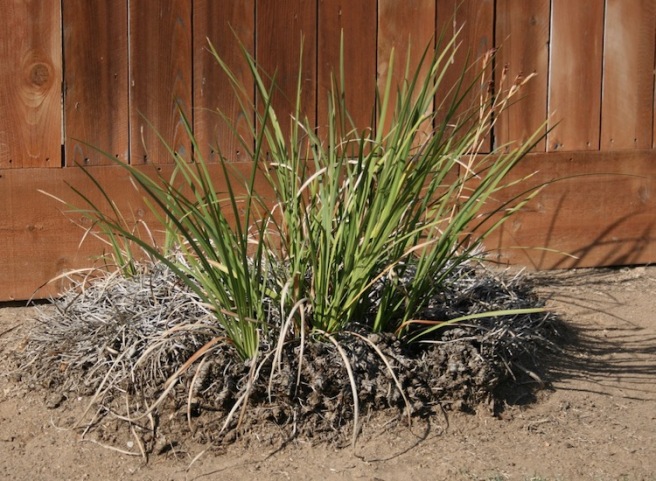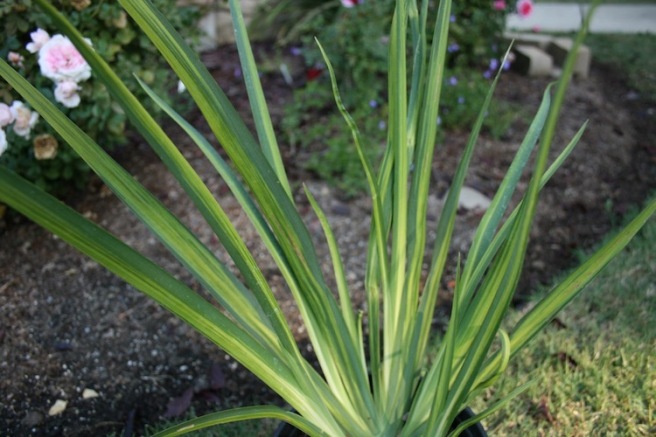
The Moraea iris is as ubiquitous to California gardens as fish tacos are to our trendy coastal restaurants. Before gardeners had ready access to a wide variety of ornamental grasses, phormiums and dianellas this evergreen perennial was one of the very few plants which fulfilled the need for a bold, contemporary and architectural element in the residential landscape. They are a landscaper’s staple here and if you drive down any residential street in my city you’d be hard pressed to find very many front yards without them. Only in the last few years has their popularity declined slightly as they do require moderate water to look their best and we now have many other choices that are less thirsty.
Dietes iridioides (D. vegeta, Moraea iridioides), commonly called the Moraea iris or fortnight lily, is an iris like perennial with fans of stiff, swordlike, dull green leaves. They are rhizomes which are almost always sold as container plants rather than barefoot and will form thick clumps of foliage over which bright white blooms seems to dance, butterfly like, throughout the year. In mild climates they may bloom year round. The flowers typically last a single day but in peak bloom periods there may be dozens on a large clump. The bloom stalks are segmented and a given stalk will produce multiple blooms throughout the season.
With all the good qualities having been mentioned–Moraea iris are among the most misunderstood, misused and as the result of these first two–misshapened–plants in California gardens today. They can grow to very large clumps and are commonly planted in areas too small to accommodate their mature size. Unless you break off the flower heads they will reseed prolifically, adding to the colony’s density and girth, seemingly exponentially. Their clumping nature really calls for them to be divided by spading them up and breaking apart the fans every 5 or 6 years during the winter. I know many gardeners but I don’t know one who has ever divided a Moraea iris–myself included. We let them grow and grow and then they look like this.

Then–when we just can’t stand it anymore and are upset by the diminishing bloom quantity–we whack them back or completely to the ground, producing these not so pleasing forms.
I am here to tell you not a single leaf that gets chopped off will ever grow again. New growth in the clump will be stimulated, making it ever so much denser and larger (which I am guessing was not the goal.) I have even seen the radical approach of mowing down the clumps like below.

New fans will emerge but nothing good will ever come of all that dead root and foliage left in the ground.
It’s a telling statement that in looking for photos for this post I could not find a single example of this plant in good shape in the square mile surrounding my home. Eveybody’s got them and they all look like crap!
And so, with all I know (and have done poorly in the past) of this perennial you will not be surprised to know that one of the first garden reno projects we tackled after purchasing our home in 2008 was to remove all the Moraea iris–14 clumps in total–from our landscape. Even today we pull up bird gifted seedlings that have wandered over from neighboring yards.
My recently retired husband (who may start looking for a job to get some rest) is all in on his dead lawn removal project which will clear the last turf from our front yard. And each of us doing what we do best, I am gathering new plant material in my holding area in anticipation of replanting the area.
I surprised myself–and him–when I purchased a gallon specimen of the Moraea’s cousin which was marked as Dietes iridioides ‘Variegata’. I am not confident of the plant ID and think that it is actually Dietes grandiflora ‘Variegata’ or ‘Sunstripe’.

The medium green foliage with bright yellow stripes is a wonderful twist on the duller green and will light up the dappled afternoon shade location I have reserved for it. The bloom on this plant is the one you see at the top of the post and it lasted for several days, which is the hallmark of the grandiflora species.

Foliage closeup!
So here is my commitment to this ‘everything old is new again’ perennial: I will revel in your beauty and DIVIDE you as is necessary to keep you happy and attractive. I will never chop your lovely stripy leaves to the ground and I will harvest your seedlings to gift to my gardening friends!



Thank you for writing about this. It is such a potentially trashy plant if not respected, but can work very well for those of us who work with it. My colleague down south grew many in his coastal garden, and divided them regularly. I grew a few in my garden in town, and also split and groomed them regularly. Those that I see around town in landscapes that are ‘maintained’ by mow blow and go type gardeners are conversely so disgraceful! Lily of the Nile gets the same sort of disregard.
LikeLike
Tony—you are so right, this plant requires active gardening participation! Unfortunately, I think it was touted as “cast iron” and “low maintenance” so often that we all thought we could plop it in there and walk away. Then we get frustrated with it and think it is incorrigible when it is really UD who’ve done IT wrong…don’t get me started on Agapanthus…
>
LikeLiked by 1 person
Oh, I so love agapanthus! . . . but I also know how it is so commonly abused. That is another topic for another time. No need to get started.
LikeLike